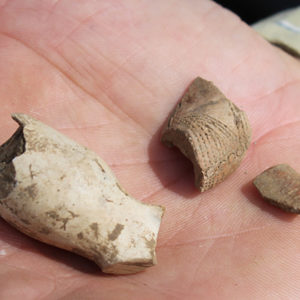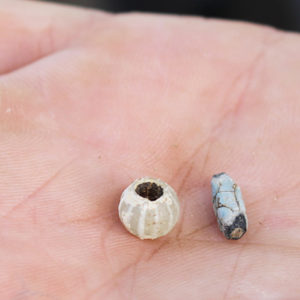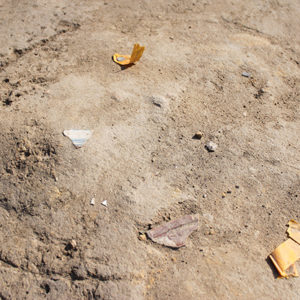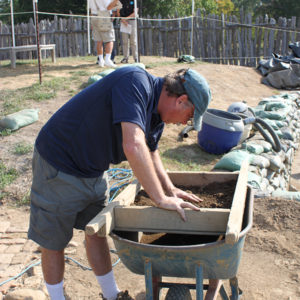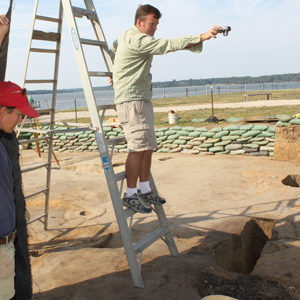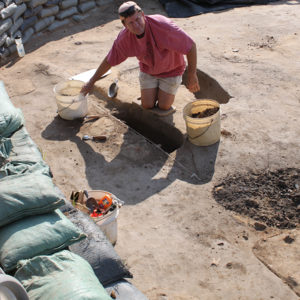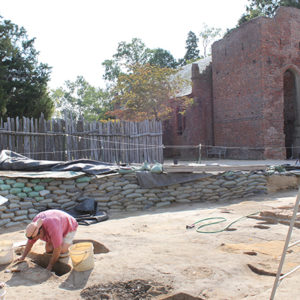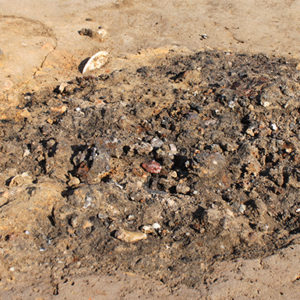Before continuing the excavations of what is probably the fort’s first substantial church—a process that will likely span well into next year’s dig season—the Jamestown Rediscovery archaeological team is tying up loose ends and completing excavations on a series of structures about 25 yards to the north. These excavations began in April and consist of a number of structures from several different time periods in the 17th century. Amidst the buildings’ archaeological remains sits a circular feature filled with charcoal, iron scrap, and other byproducts of iron making. This dark, rough footprint likely belonged to a furnace, perhaps tied to the colony’s first efforts at iron making in 1608.
One of the buildings currently being excavated has a length and width of twenty feet. All eight of the structure’s postholes have been found. The building postdates a ca. 1610 rowhouse nearby that is thought to be the governor’s residence. A 1617 addition to the rowhouse, constructed during the governorship of Samuel Argall, also predates the building in question. Archaeologists are able to come to these conclusions based on the positions of features as they come into contact with and overlap each other. Features that cut into others are newer than those being cut into. By examining features of the 20′ x 20′ building that occupy the same ground as the rowhouse and its addition, the archaeologists observed the 20′ x 20′ building features had cut through those of the other structures. Thus the 20′ x 20′ building postdates the rowhouse and its addition.
A European pipe bowl found in one of the building’s postholes has gone a long way in helping to date it. As the amount of tobacco exported to Europe increased and was thus more plentiful (and cheaper) to consumers, European pipes followed a pattern of having larger and larger bowls. Comparing the excavated pipe to this pattern suggests that it was made in the 1620s or 1630s. The 20′ x 20′ structure could not have been constructed before that time. The archaeologists aren’t sure what type of building this was and are hoping that further excavations might yield some clues.
Other artifacts found while excavating the building include a Nueva Cadiz-type bead, a copper patch used for repairing a metal vessel, a lead cap from a bandolier cylinder, and a sherd from a Bartmann jug. This sherd mends to a jug that was found in the 1611 well excavated in 2006. Senior Curator Bly Straube remarked that it’s hard to put any of the artifacts in storage because every so often a missing piece of a puzzle will turn up. The jug, which is becoming more and more complete, bears an imperial double-headed eagle and the date 1604.
related images
- ’04’ is visible on the larger fragment of the Bartmann jug. ’16’ would have been visible on the other side of the double-headed eagle.
- A European pipe bowl (left) found during the 20′ x 20′ structure excavations. Also found were fragments of two ornate Virginia Indian pipe bowls.
- A gooseberry bead and a Nueva Cadiz-type bead
- A posthole with artifacts in situ
- Archaeologist Chuck Durfor screens for artifacts in the excavated soil
- Archaeologist David Givens takes an overhead shot of the furnace feature. He will then place the image on a map using GIS coordinates.
- Archaeologist Don Warmke excavating one of the buildings near the furnace
- Archaeologists Mary Anna Richardson and Don Warmke conducting excavations. The ashy furnace pit can be seen at the bottom center of the photo.
- Senior Curator Bly Straube holds the newly-found Bartmann jug sherd next to the larger fragments found in 2006.
- The furnace feature




